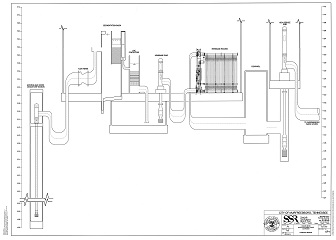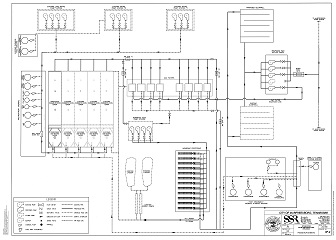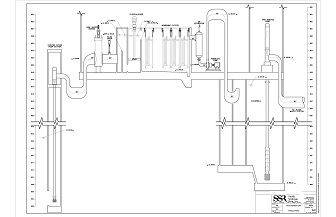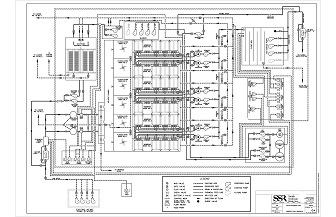EXAMPLE PLANS & SPECIFICATIONS
Click images to enlarge. Photos courtesy of Smith Seckman Reid, Inc.
|
Hydraulic Profile
Process Flow Schematic |
The membrane filtration plant shown on the left was originally designed in 1966 as an 8.0 MGDMGD: MGD stands for Million Gallons per Day and is a unit of flow measure. plant. In 1979, Smith seckman Reid, Inc. (SSR) designed an expansion to increase the plant's capacity by 50%. In 2004, the plant requested SSR to design an expansion of the treatment plant to 20.0 MGD using membrane filtration technology, as well as to make numerous renovations to the existing plant in order to meet current and proposed regulations. This project required SSR to design a completely new plant around an existing plant that could not be off line for more than 8 hours. The initial design and coordination required was extremely challenging. The project required integrating the complicated processes of lime softening, membrane filtration, GAC contactors, a new clearwell, and chemical feed into an existing operational plant. Additionally, the entire electrical system was replaced which required a new transformer, generator set, and service entrance. One interesting aspect of this plant is its capability to utilize GAC adsorption either before or after membrane filtration. This was accomplished by the creative placement of yard piping and utilization of existing structures to convey the water to either location within the constraints of the existing hydraulic grade. To accomplish this feat, the existing flash mix was repurposes as an air gap to keep separation between membrane filtered water and settled water. |
|
Hydraulic Profile
Process Flow Schematic |
The membrane filtration plant shown on the left is a 16.0 MGD enhanced coagulation membrane filtration water treatment plant. Filtration is accomplished using ZeeWeed® 500D series immersed, vacuumVacuum systems: Vacuum membrane systems are microfiltration or ultrafiltration systems in which the membranes are immersed in a tank of water and a vacuum applied to pull the water through the membrane. driven membranes provided by GE-Zenon. The plant is expandable to 19.6 MGD by the addition of six ZeeWeed® Cassettes. The plant has an ultimate capacity of 24.0 MGD by the addition of three new trains. The water plant is housed in a 40,000 square foot building and office complex across the street from the existing water treatment plant. In addition to the new membrane system, the utility has chosen to generate sodium hypochlorite on-site. The utility decided to move away from gaseous chlorine for safety reasons. An economic evaluation determined on-site generation provided a less expensive life-cycle costsLife-cycle costs: Life-cycle costs include all the costs associated with an asset, i.e., cradle to grave costs including initial purchase/construction costs, operation and maintenance costs and final disposal/demolition costs. than purchasing bulk bleach over a 20 year period. Rising chlorine and bulk bleach prices have further confirmed the wisdom of this choice. Filtration is achieved by drawing water to the inside of the membrane fiber under a partial vacuum. The treated water (permeatePermeate: Permeate is synonymous with filtrate but is typically used with reverse osmosis and nanofiltration systems.) is conveyed to the main permeate collection pipes. ZeeWeed® 500D membranes utilize "Outside-In" flow through reinforced, hollow-fiberHollow-fibers: In hollow-fiber membranes, the membrane consists of a long spaghetti-like tube with a hollow core. The fibers are bundled together with the open ends encased in a resin. Flow can pass through the membrane either from the outside into the hollow membrane center or from the inside to the outside. Hollow fibers are typically used in microfiltration (MF) and ultrafiltration (UF) membrane processes. membranes that have nominal and absolute pore sizes of 0.04 and 0.1 microns respectively. The small pore size excludes particulate matter including solids, bacteria, pathogensPathogens: Pathogens are disease causing microorganisms. Two of the most important pathogens driving interest in membrane systems are Giardia and Cryptosporidium. and certain viruses. This membrane is being applied successfully in a variety of applications and demonstrates excellent performance in applications where high solids and/or variable feed waterFeed water: The feed water is the water stream applied to the membrane unit. quality are typical including wastewater treatment. |















